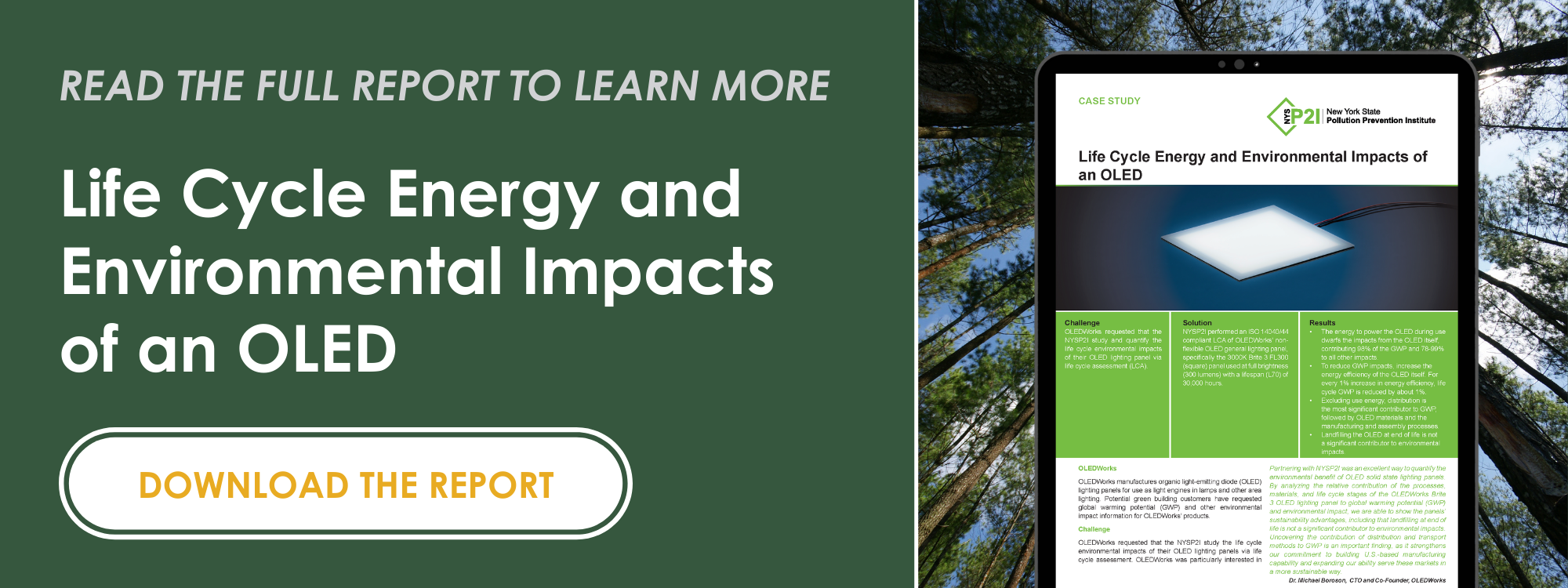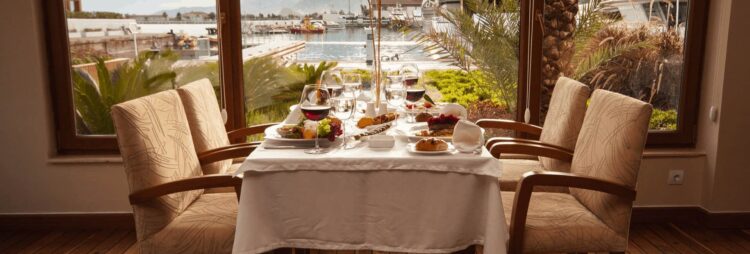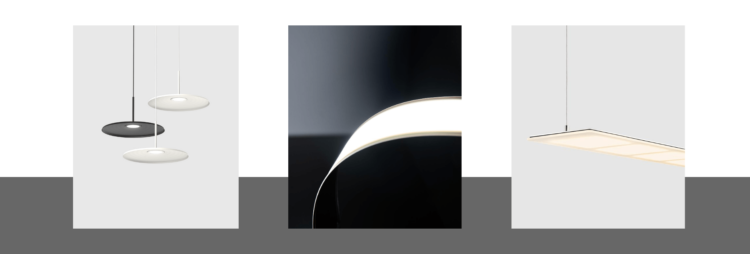
By Dr. Kathleen Vaeth, Director of OLED User Experience (UX)
Key Takeaways from the Study
- The total global warming potential (GWP) of our Brite 3 OLED lighting panel is 77.5 kg of CO2e (carbon dioxide equivalent) over its lifetime—the same amount of emissions that an average car emits after traveling 195 miles.
- Excluding the use of energy, the GWP impact of the Brite 3 lighting panel is minimal.
- With few components and the use of environmentally friendly materials, landfilling at end of life is not a significant contributor to environmental impacts for the impact categories that were considered in this study.
- With 98 percent of the panel’s GWP driven by energy consumption during use, the environmental impact of OLED lighting will decrease significantly as panel efficacy rises.
———
As product designers, we have a responsibility to understand how what we manufacture and sell impacts the environment. Recently, OLEDWorks collaborated with the New York State Pollution Prevention Institute (NYSP2I) at the Golisano Institute for Sustainability at Rochester Institute of Technology (RIT) to conduct a life cycle assessment (LCA) of our Brite 3 OLED lighting panels. The project was partially funded by the New York State Department of Environmental Conservation (NYSDEC).
Sometimes referred to as a “cradle to grave” study, an LCA looks at how a product impacts the world around it. It is a comprehensive analysis, considering the raw materials and manufacturing processes that go into making a product, as well as the ways that it is used and ultimately disposed of. An LCA helps a company better understand a product’s sustainability across its entire life, quantifying its impact on key factors, including global warming, resource consumption, water, and terrestrial eco-toxicity, air quality, and human health.
About the LCA
To conduct the study, NYSP2I ran the square, warm-white 3000K version of our Brite 3 FL300 OLED lighting panel and driver at full brightness (this is called the “functional unit” by LCA specialists). Under these conditions, the panel has an output of 300 lumens (lm) and a lifespan (L70) of 30,000 hours.
The life cycle stages considered in the study were:
- raw materials
- product manufacturing and assembly
- packaging
- distribution
- consumer use
- disposal in a landfill
The segment of the Brite 3’s life cycle that was studied began with production in our manufacturing facility in Aachen, Germany, then followed its shipment to North America and tracked consumer use there.
Eighteen environmental impact factors were quantified. Particular focus was given to GWP because it allows easy comparison of the results with different LCA databases and methodologies.
Energy use dominates Brite 3’s environmental impacts
The study found that the GWP of a Brite 3 OLED panel is 77.5 kg CO2e over its lifetime, which is equivalent to the average car driving 195 miles. To put that in perspective, that is less than the distance of a one-way car ride from New York City to Washington, D.C.

As with most electrically powered products, generation of the energy required to power the panel during use dominates the environmental impact of the panel, contributing to 98 percent of the total GWP, and 78–99 percent to all other impact factors. This is consistent with LCA studies of other solid-state lighting technologies, such as inorganic LEDs.
We found through the study that the best opportunity for lowering our technologies’ environmental impact is to increase the panel efficacy. In fact, for every 1 percent increase in energy efficiency of the lighting panel, life cycle GWP is reduced by about 1 percent.

The energy efficiency of OLED lighting panels has doubled over the past five years, with efficacies as high as 85 lumens per watt (lm/W) available commercially. This trend is expected to continue. In fact, panel efficacies of 105 lm/W have already been shown recently as part of OLEDWorks projects sponsored by the U.S. Department of Energy (DOE). Commercialization of these and other technology improvements related to panel efficacy will make OLED lighting panels even more sustainable in the next few years.
Brite 3 design and manufacturing have little impact on environment
To understand how OLED panel design choices and manufacturing processes contribute to environmental impact, the GWP excluding product use energy is typically considered. Excluding power consumption, the GWP of Brite 3 OLED panels is equal to 1.33 kg CO2e, or the equivalent of the average car driving 3.3 miles down the road.
The following key areas contributed the most to the GWP excluding product use:
- distribution: 44%
- materials Use: 26%
- manufacturing processes: 16%
- panel packaging and driver: 10%
- landfill disposal: less than 0.5%
The smaller contribution to environmental impact from OLED panel materials and disposal is worth noting, as it highlights how OLED lighting has very few parts, and those that are used are environmentally friendly.
As stated earlier, the study assumed the current practice of flying the panel from its manufacturing location in Germany to North America, followed by short range trucking to the customer.
To understand how a different distribution channel could reduce the overall environmental impact, the study also considered an alternative scenario where products were shipped from Germany to North America on a seafaring vessel followed by trucking to the customer. This was found to reduce the distribution contribution to GWP excluding use energy by 95 percent and had significant reductions in nearly all other environmental impact factors.
Therefore, the next significant opportunity for reducing the environmental impact of our Brite 3 OLED lighting panels is to develop and implement more environmentally friendly distribution methods.
Creating a more sustainable light
The results from the LCA study are compelling and partnering with NYSP2I was an excellent way to quantify the environmental benefits of our Brite 3 OLED lighting panels.
By analyzing the relative contribution of the processes, materials, and life cycle stages of the Brite 3 to GWP and other environmental-impact indicators, we can show the panels’ sustainability advantages.
Continued advances in OLEDWorks’ lighting panel efficacies will pave the way for even further reductions in GWP and other environmental impact factors. Uncovering the contribution of distribution and transport methods to GWP was an important finding, as it strengthens our commitment to finding more efficient methods of distribution and expanding our ability serve these markets in a more sustainable way.
With the ongoing innovation of manufacturing processes, distribution, and panel performance, OLEDWorks’ OLED lighting technology will continue its evolution as a sustainable light source.



